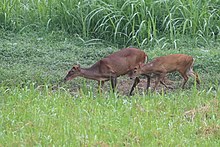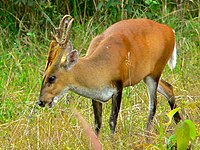Southern red muntjac
This article needs additional citations for verification. (October 2015) |
| Southern red muntjac | |
|---|---|

| |
| Adult female and offspring (Muntiacus muntjak), in Malaysia, September 2012 | |
| Scientific classification | |
| Domain: | Eukaryota |
| Kingdom: | Animalia |
| Phylum: | Chordata |
| Class: | Mammalia |
| Order: | Artiodactyla |
| Family: | Cervidae |
| Subfamily: | Cervinae |
| Genus: | Muntiacus |
| Species: | M. muntjak
|
| Binomial name | |
| Muntiacus muntjak (Zimmermann, 1780)
| |

| |
| Range of the northern red muntjac (M. vaginalis) and the southern red muntjac (M. muntjak) | |
| Synonyms | |
| |
The southern red muntjac (Muntiacus muntjak) is a
This muntjac has soft, short, brownish or grayish hair, sometimes with creamy markings. It is among the smallest deer species. It is an
Name
The species was formerly classified as Cervus muntjac.[3]
Characteristics

The Southern red muntjac has a short but very soft, thick, dense coat that is more dense in cooler regions. Its face is darker and the limbs are dark to reddish brown and the coat color seasonally varies from darker brown to yellowish and grayish brown and is white ventrally. Its ears have much less hair, but otherwise are the same color as the rest of the head. Male muntjacs have short antlers, about 10 cm (3.9 in) long, that protrude from long body hair-covered pedicels above the eyes. Females have tufts of fur and small bony knobs instead of antlers. Males also have elongated (2–4 cm (0.79–1.57 in)), slightly curved upper canines, which can be used in male-male conflicts and inflict serious injury. The body length of muntjacs varies from 89–135 cm (35–53 in), with a 13 to 23 cm (5.1 to 9.1 in) long tail, and shoulder height ranging from 40 to 65 cm (16 to 26 in). Adult weight ranges between 13 and 35 kg (29 and 77 lb),[4][5] with males being larger than females. Muntjacs are unique among the deer, having large, obvious facial (preorbital, in front of the eyes) scent glands used to mark territories or to attract females. Males have larger glands than females.[6]
Distribution and habitat
The southern red muntjac (previously known as the common muntjac) is one the least known mammals of Southeast Asia. It is found in the Malay Peninsula, Sumatra, Java, Bali and Borneo.[1] It is also assumed to be present in peninsular Thailand and southwestern Myanmar.[1] It is extinct in Singapore.[1]M. muntjak is a terrestrial mammal that live in forests and is resilient to changes in its habitat.[1]
Distribution of subspecies (MSW3)
There were 15 subspecies included under the species in
- M. m. annamensis, Indochina
- M. m. aureus, peninsular India
- M. m. bancanus, Belitung and Bangka Islands
- M. m. curvostylis, Thailand
- M. m. grandicornis, Burmese muntjac, Burma
- M. m. malabaricus, South India and Sri Lanka
- M. m. montanus, Sumatran or mountain muntjac, Sumatra
- M. m. muntjak, Javan muntjac, Java and south Sumatra
- M. m. nainggolani, Bali and Lombok Islands
- M. m. nigripes, black-footed or black-legged muntjac, Vietnam and Hainan Island
- M. m. peninsulae, Malaysia
- M. m. pleicharicus, South Borneo
- M. m. robinsoni, Lingga Islands
- M. m. rubidus, north Borneo
- M. m. vaginalis, Burma to southwest China
Distribution of subspecies (IUCN and MDD)
1-2 of them have since been elevated to species status :
The subspecies bancanus, montanus, muntjak, nainggolani, peninsulae, pleiharicus, robinsoni, rubidus are included in the southern red muntjak (M. muntjak), while annamensis, aureus, curvostylis, grandicornis, nigripes are included in the northern red muntjac (M. vaginalis).[11]
Ecology and behavior
The Southern red muntjac is also called "barking deer" due to the bark-like sound that it makes as an alarm when danger is present. Other than during the
Predators of these deer include
Reproduction
The Southern red muntjacs are polygamous animals. Females become sexually mature during their first to second year of life. These females are polyestrous, with each cycle lasting about 14 to 21 days and an estrus lasting for 2 days. The gestation period is 6–7 months and they usually bear one offspring at a time, but sometimes produce twins. Females usually give birth in dense growth so that they are hidden from the rest of the herd and predators. The young leaves its mother after about 6 months to establish its own territory. Males often fight between one another for possession of a harem of females. Muntjacs are distinguished from other even-toed ungulates in showing no evidence of a specific breeding season within the species. Adults exhibit relatively large home range overlap both intersexually and intrasexually, meaning that strict territorialism did not occur but some form of site-specific dominance exists.[13]
Evolution and genetics

Threats
Southern red muntjacs are hunted for sport and for their meat and skin around the outskirts of agricultural areas, as they are considered a nuisance for damaging crops and ripping bark from trees.
References
- ^ . Retrieved 10 February 2023.
- ^ "Muntiacus muntjak". Animal Diversity Web. Retrieved 2017-12-02.
- ^ "Burmah", Encyclopædia Britannica, 9th ed., vol. Vol. IV, 1876, p. 552
- ^ animaldiversity
.org /accounts /Muntiacus _muntjak / - ^ a b eol
.org /pages /308397 /data - PMID 977477.
- OCLC 62265494.
- .
- ^ "Muntiacus vaginalis (id=1006338)". ASM Mammal Diversity Database. American Society of Mammalogists. Retrieved 10 February 2023.
- ^ "Muntiacus malabaricus (id=1006331)". ASM Mammal Diversity Database. American Society of Mammalogists. Retrieved 10 February 2023.
- ^ "Muntiacus muntjak (id=1006332)". ASM Mammal Diversity Database. American Society of Mammalogists. Retrieved 14 February 2023.
- International Union for Conservation of Nature and Natural Resources. pp. 584–602.
- PMID 17614268.
- ^ S2CID 45371297.
- ISBN 9780731402366.
Further reading
- Hutchins, M., ed. (2004). "Muntjacs". The Gale GroupInc.
- Kurt, F. (1990). "Muntjac Deer". Grzimek's Encyclopedia of Mammals. Vol. 5 (1 ed.). St. Louis: McGraw-Hill.
- Nowak, R.M. (1999). "Muntjacs, or Barking Deer". Walker's Mammals of the World. Vol. 2 (6 ed.). Baltimore: The Johns Hopkins University Press.




